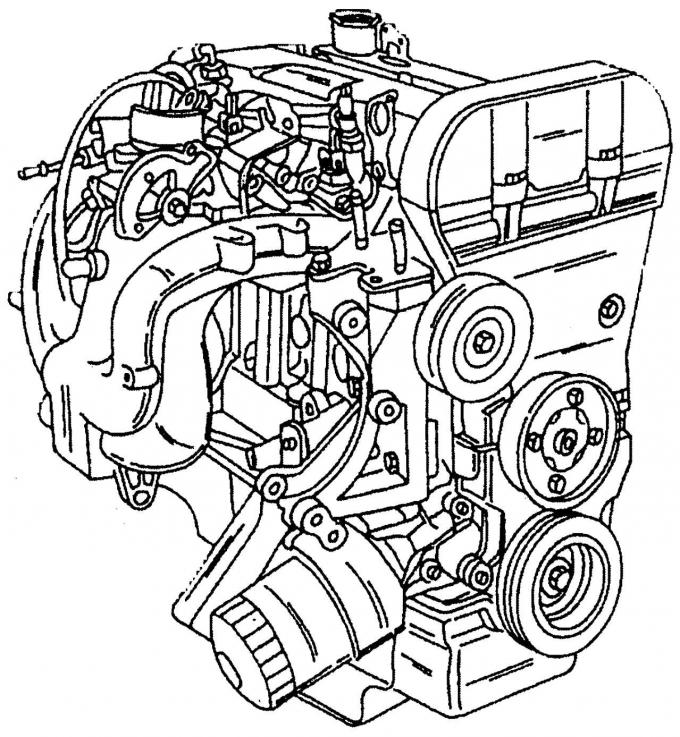- the body is made as streamlined as possible and provides maximum safety for passengers;
- the airbag system is installed as standard on the driver's side, on request the airbag can be installed on the front passenger side. All vehicles are fitted as standard with seat belt pretensioners;
- by special order, limousines are supplied with an electronically controlled system of automatic suspension adjustment. Station wagons can be fitted with the Boge-Nivomat self-leveling system already used on Sierra vehicles;
- under the order or serially installed electronically controlled anti-lock braking system (ABS). In this case, a hydraulic control device from Bendix is built into the conventional brake circuit. On models equipped with ABS, an electronic wheel drive control system can also be integrated to control wheel slip on wet or icy roads;
- all models are equipped with an electronic engine management system with a computer and a catalytic converter;
- a dual-circuit brake system with diagonal brake wiring is installed. In the basic version, blown brake discs with sliding brake saddles are installed on the front wheels and drum brakes on the rear wheels. On the pressure and release brake pads of the rear wheel brakes, the thickness of the brake pads is selected in such a way as to ensure their uniform wear. On more powerful models, disc brakes are used for the rear wheels. In this case, disks made of hard material and brake saddles with anti-phase pistons are installed. On all versions with non-ABS braking systems, pressure reducing valves are installed in the outlet ports of the master brake cylinder in order to regulate the hydraulic pressure on the rear wheels and thereby reduce the risk of rear wheel lockup during hard braking;

Pic. 1. General view of the 16V engine
- The 16V engines installed on the Mondeo have been slightly modified since the start of production in May 1998. Until that time, they developed 66, 85 and 100 kW. All three engine versions have an identical crankshaft. Various cylinder volumes are achieved by changing the diameter of the cylinders. These engines are called Zetec-E. The power of the 1.6- and 1.8-liter engines was retained after May 1998, the power of the 2.0-liter engine was reduced to 96 kW. In sec. «Engine» the design of the engines, as well as the changes that have affected them since May 1998, are considered in more detail. 1 shows a general view of the engine;
- the 2.5 liter engine is offered in two versions. The base model of the engine develops a power of 125 kW. In addition, under the brand name 2.5 ST 200, a 151 kW engine is sold, referred to as 2.5 Duratec-VE. Due to the large difference between the 16V engines and the 2.5 liter engine, the latter is described in a separate section at the end of the manual;
- all cars with petrol engines comply with the environmental regulations of environmental protection - 96 EEC;
- in Mondeo vehicles, the MTX 75 gearbox, already tested on previous models, is used; only gear ratios have changed somewhat to better match the weight of the car and engine power. Clutch - non-self-adjusting;
- the vehicles use a new automatic transmission, the hydraulic shifting of which is electronically controlled via the EEC V module. If the electronic control system fails, an emergency program is activated. The box has four forward gears due to two drives on planetary gears. Engine braking is carried out in all gears;
- front wheel suspension consists of shock absorber struts with wishbones and anti-roll bar. The wishbones and the stabilizer are mounted on a subframe, separately screwed to the bottom of the vehicle. Wishbones with rubber mounts are mounted with horizontal and vertical screws on the subframe. On the outside of each transverse suspension arm, a suspension ball joint is mounted, which is connected to the pivot pin. Mondeo with 272 kW engine has a different wishbone. The car is driven through drive shafts with constant velocity joints;
- the suspension of the rear wheels on a limousine consists of rods and shock absorber struts of the McPherson type. These are two horizontal tie rods on each side of the vehicle, which are attached at one end to the rear suspension beam and the other end to the cast iron rear wheel hub bracket. The third arm is a brace that connects the wheel bracket to the bearing bracket in front of it on the body. The spacers counteract the braking forces. A shock strut mounted on top of the wheel bracket detects rear wheel camber and counteracts braking torques;
- on a station wagon, three independent suspension arms are used on each side - one forged upper arm and two stamped lower side arms. The side arms are mounted in rubber mounts on the cross member and wheel bracket. A stabilizer bar is installed as standard. As on limousines, one spacer, firmly screwed in rubber supports to the bottom and wheel bracket, is mounted on each side of the car. Shock absorbers and coil springs are located separately (also on vehicles with self-levelling). The shock absorbers are installed between the wheel brackets and the cross beams; coil springs are located between the lower side arms and the cross member. This made it possible to produce a flat cargo compartment for the station wagon.
Visitor comments